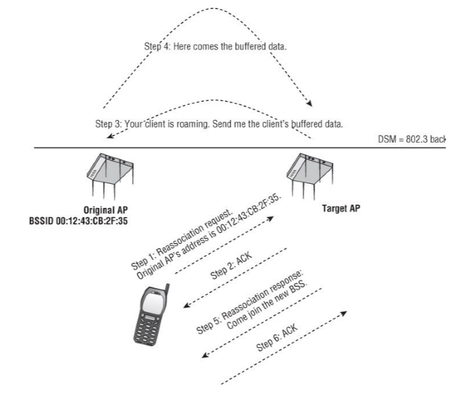Association, reassociation, and disassociation
. . . .
Association
Reassociation
- After the station has authenticated with the AP, the next step is for it to associate with the AP.
- When a client station associates, it becomes a member of a basic service set (BSS).
- Association means that the client station can send data through the AP and on to the distribution system medium.
- The client station sends an association request to the AP, seeking permission to join the BSS.
- The AP sends an association response to the client, either granting or denying permission to join the BSS.
- In the body of the association response frame is an association identifier (AID), a unique association number given to every associated client.
- The AID is used during power management.
- Association occurs after Shared Key or Open System authentication.
- After a client station becomes a member of the BSS by completing association, the client will begin communications at upper layers and establish IP connectivity.
Reassociation
- When a client station decides to roam to a new AP, it will send a reassociation request frame to the new AP.
- It is called a reassociation not because you are reassociating to the AP but because you are reassociating to the SSID of the wireless network.
- Reassociation occurs after the client and the AP move through a serious of steps, as described here:
- In the first step, the client station sends a reassociation request frame to the new AP.
- The new AP then replies to the station with an ACK.
- The new AP attempts to communicate with the original AP by using the distribution system medium (DSM).
- If this communication is successful, the original AP will use the distribution system medium to forward any buffered data to the new AP.
- The new AP sends a reassociation response frame to the roaming client via the wireless medium.
- The client sends an ACK to the new AP, confirming that it received the forwarded data.
- If the reassociation is not successful, the client will retain its connection to the original AP and either continue to communicate with it or attempt to roam to another AP.
- As shown in Figure 9.7, the reassociation request frame includes the BSSID (MAC address) of the AP it is currently connected to (we will refer to this as the original AP).
Disassociation
- Disassociation is a notification, not a request.
- If a station wants to disassociate from an AP, or an AP wants to disassociate from stations, either device can send a disassociation frame.
- This is a polite way of terminating the association.
- A client will do so when you shut down the operating system.
- An AP might do so if it is being disconnected from the network for maintenance. Disassociation cannot be refused by either party, except when management frame protection (defined in 802.11w) is negotiated and the message integrity check (MIC) fails.
If the disassociation frame is not heard by the other party, MAC management is designed to accommodate loss of communications.
Reference:
Coleman, David D.,Westcott, David A. CWNA: Certified Wireless Network Administrator Official Study Guide: Exam CWNA-106 Wiley.
Coleman, David D.,Westcott, David A. CWNA: Certified Wireless Network Administrator Official Study Guide: Exam CWNA-106 Wiley.
|
|

